Artist's Note
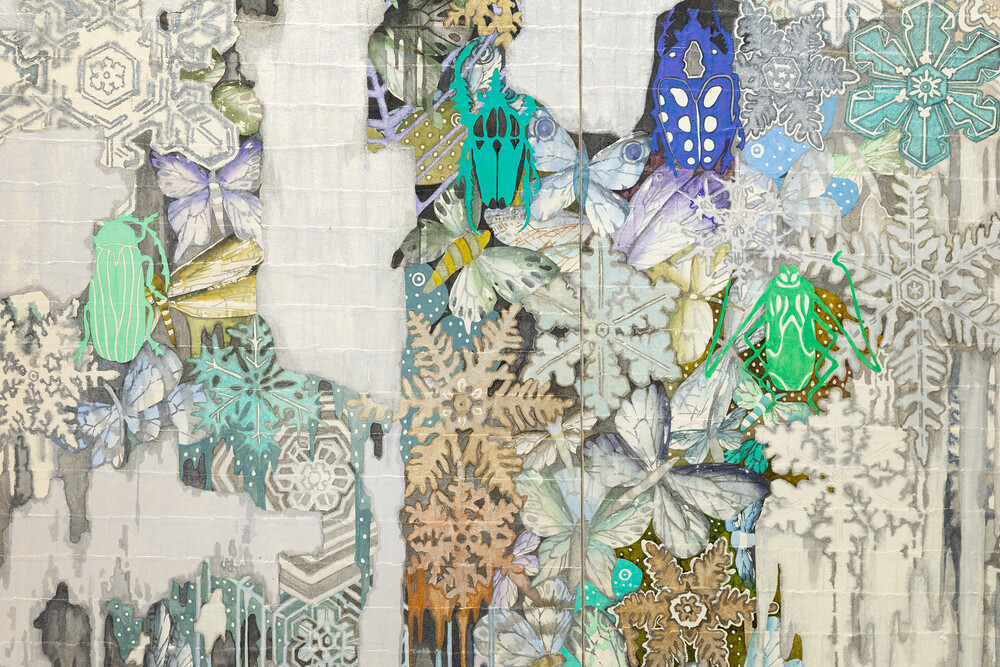
그림 속 낡은 벽은 시간의 경과로 인해 또 인공적인 파괴로 인해 황폐되어 불완전하지만, 인간이 만든 형태와 유기적인 자연의 조합을 표상한다. 폐허 표상이 보여주는 매력은, 첫째로, 고대 건축물과 근대 건축물, 벽과 원주 등이 결합된 하이브리드적(hybrid) 성격, 둘째로, 나무와 풀 같은 식물 생태와 연계된 독특한 시적 서정성, 셋째로, 아무것도 남아있지 않은 돌덩이에 몽상을 그려 넣어 화석(化石)으로 각인시키는 점 등이다. 나의 작업은 황폐와 장대함에 대한 감성을 바탕으로 하고 있으며 여기에 언젠가는 무(無)가 될 폐허와 죽음을 피할 수 없는 인간의 존재를 중첩시킨다. 유구한 과거를 생각하면서도 또 사멸로 향하는 미래의 유구한 시간으로, 좋든 싫든 의식을 향하게 하여, 그러한 두 개의 영원 사이에 서 있는 인간의 존재의 덧없음을 느낀다.
벽에 새겨진 흔적들은 과거와 현재의 시간적 거리를 환기시키는 자연의 기호이자 한편의 시이다. 나는 지금 벽을 통해 시간성을 깨닫고, 시간의 무게를 깊이 있게 생각한다. 역사 속에서 증명해 온 생명의 힘과 죽음이라는 소멸을 표현하는 작품들을 통해 인간의 삶을 위로하고 미세먼지와 초고밀도 회색으로 가득 찬 도시에서 불안한 시간을 살고 있는 우리에게 또 다른 행복의 단서를 발견하게 하고 싶다.
“워낙 오래 갇혀 살아서 저걸 벽처럼 생각하게 됐는데 사실은 문이란 말이지.”
- 영화 〈설국열차〉 중에서
Old walls in picture have fascinated artists, poets, scholars, and tourists for many years. Although the ruins are devastated and incomplete by time and artificial destruction, it represents a combination of manmade form and organic nature. The attractions of the representation of the ruins are: 1)Hybrid characteristics of the combination of ancient and modern architecture, or wall and column. 2)Unique poetic lyricism associated with plant ecosystem consisted of trees and grass. 3)To stamp with a fossil through drawing his fantasy on a rock with nothing left. My works is based on the contemporary perception of the devastation and grandeur of ancient Rome, and is supported by knowledge of the structure of human anatomy and its way of presentation. Humans overlap the ruins that will one day become nothing and their inevitable existence of death. Thinking about the long past, and also facing consciousness as the long time in the future toward death, they feel the transient between those two eternity.
The traces carved on the wall were signs and poems that evoke time distance between the ancient and the present. I realize the timelessness of time through the ruins now , and think deeply about the weight of time. Through works that express the power of life and the extinction of death that have been proven throughout history, I want to comfort human life and help us, who are living in anxious times in a city filled with fine dust and ultra-high density gray, find another clue to happiness.
“I’ve been locked up for so long that I’ve come to think of it as a wall, but it’s actually a door.”
- From the movie Snowpiercer
벽에 쓰는 시 (Poetry on the wal), 2025 구본아
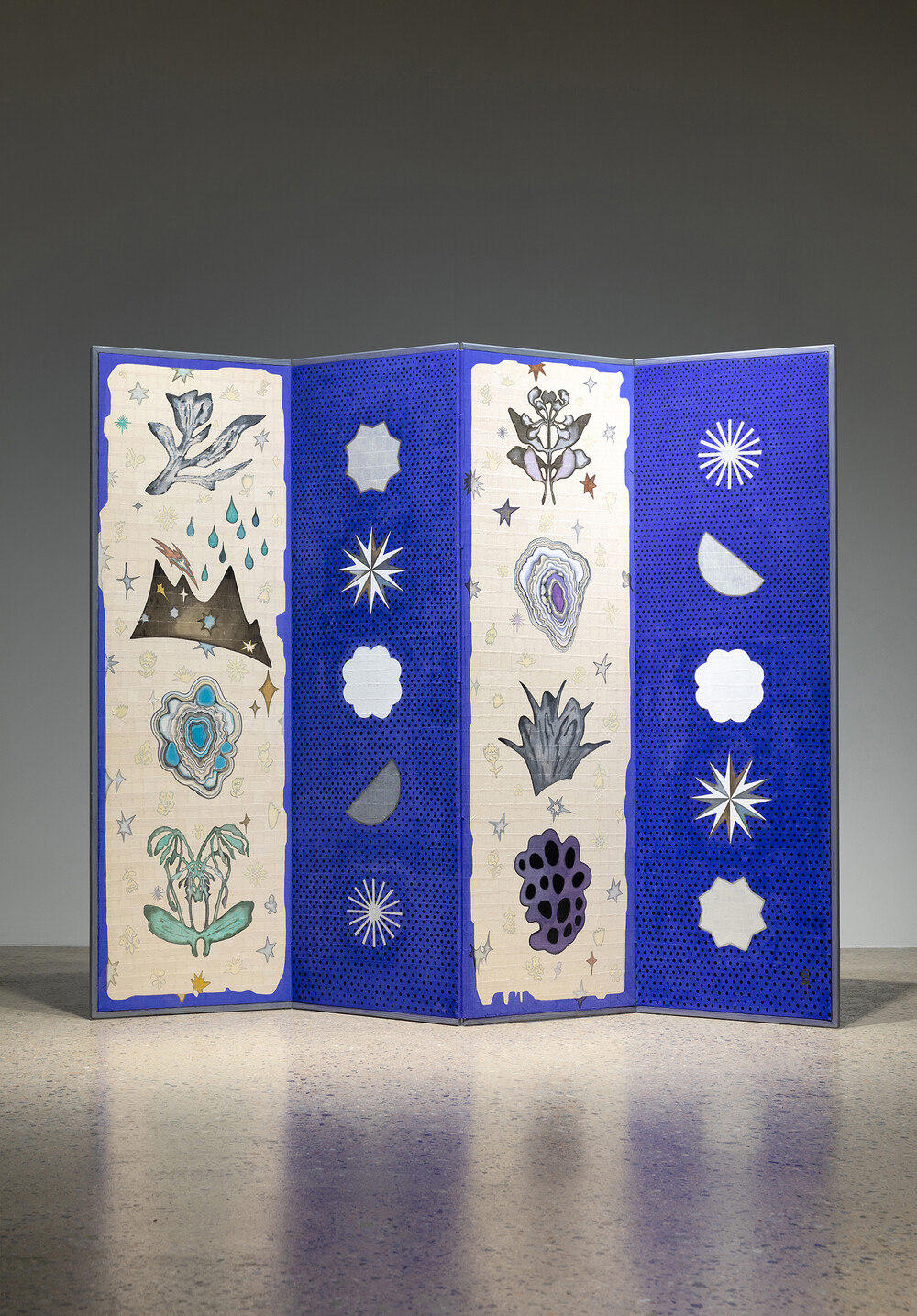
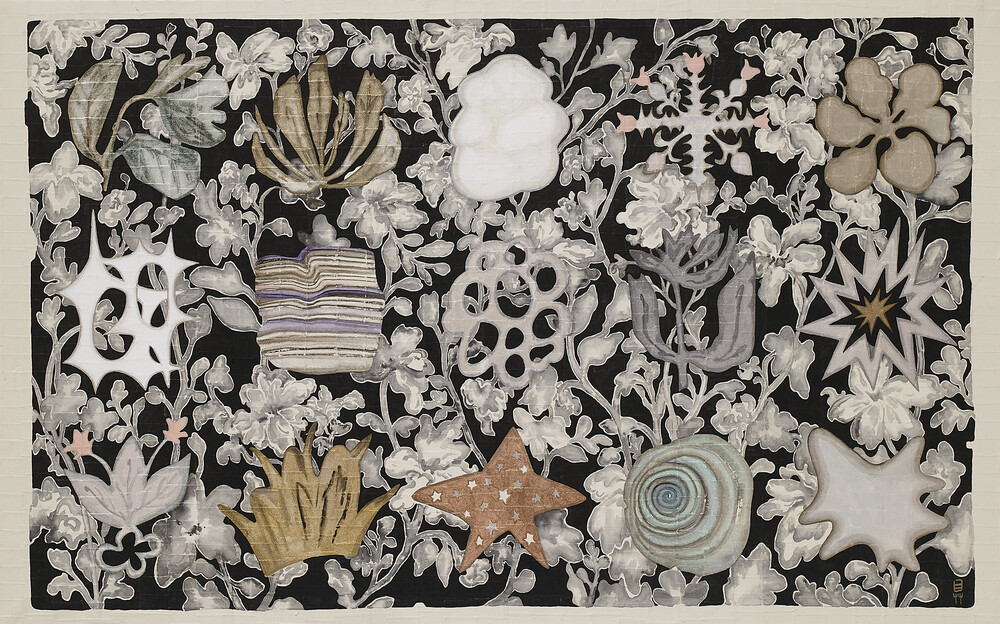
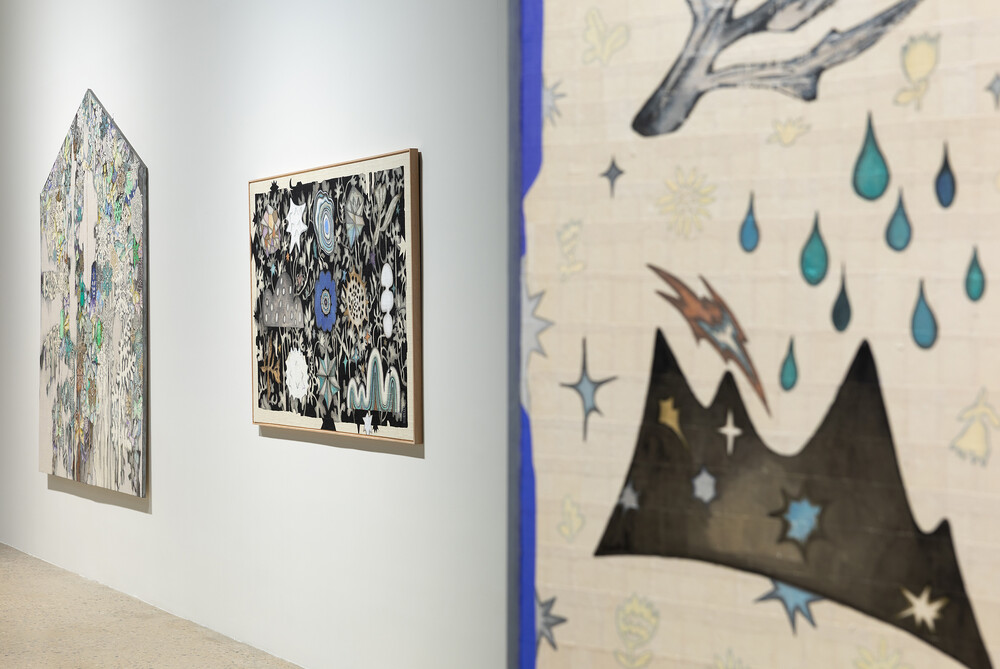
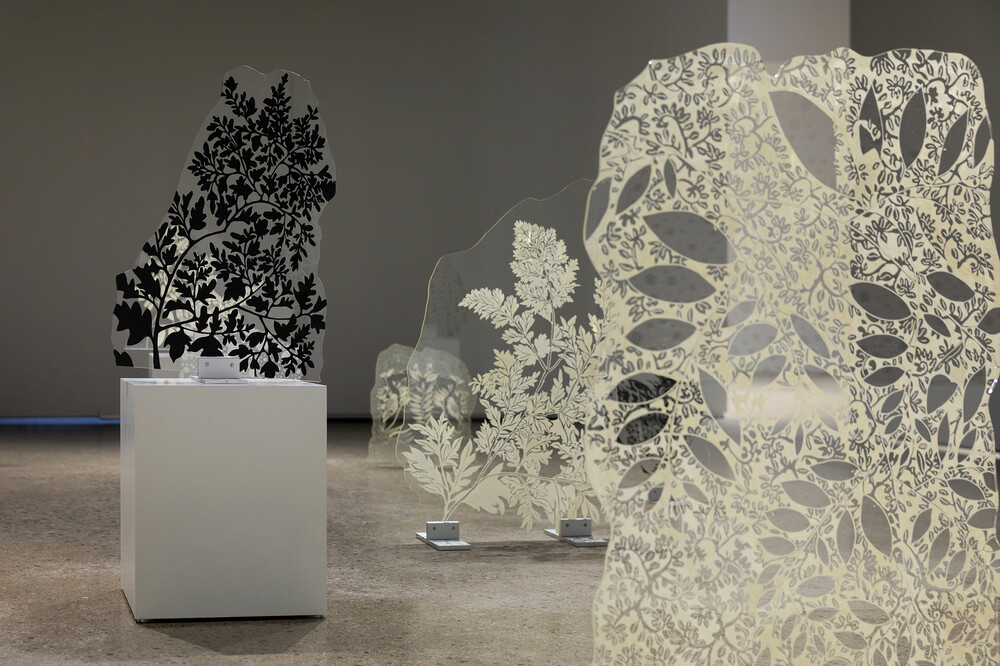
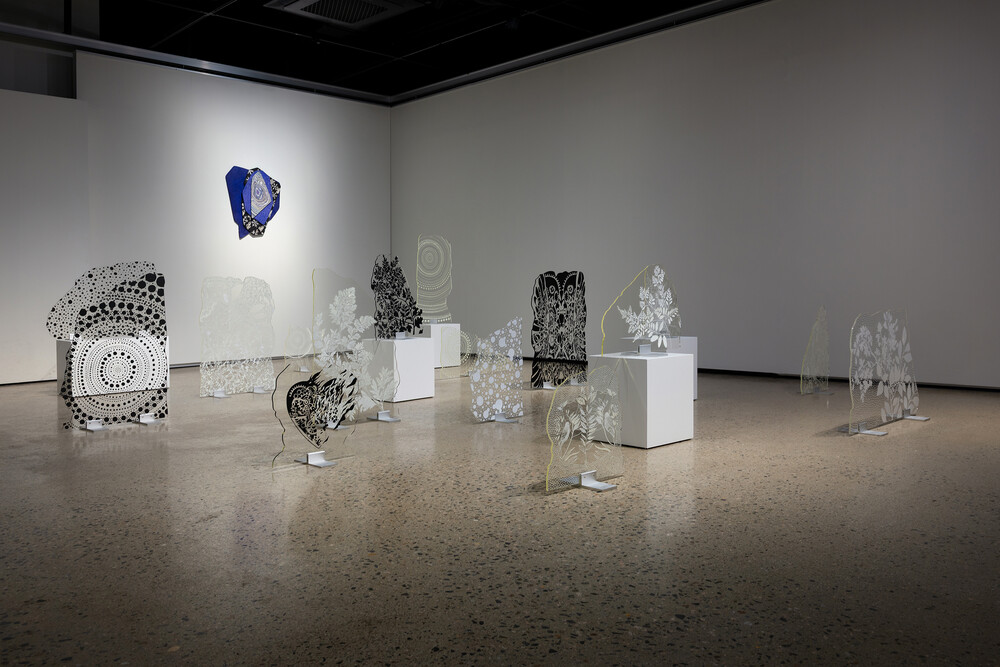
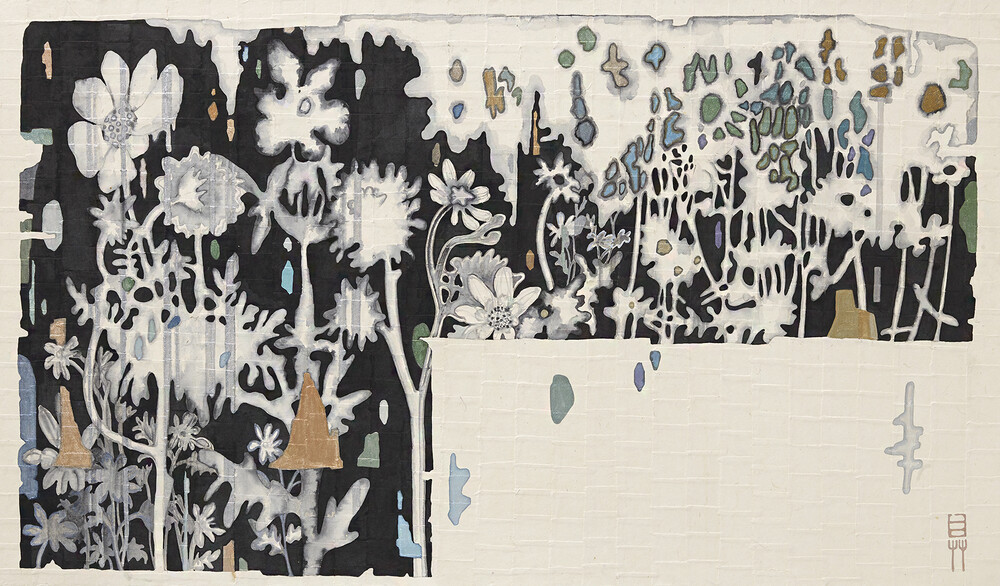
공진화(共進化)는 한 생물집단이 다른 생물집단과 함께 진화한다는 생물학적 개념으로, 이는 모든 개체가 언제나 각자의 생존을 위해 중첩되어 진화했다는 것을 일깨운다. 이번 전시를 통해, 도시의 콘크리트 벽과 자연물질, 또한 자연과 자연사이의 유사성과 이질성을 통해 미완과 붕괴의 이중성을 담고자 하였고 인간과 연결된 존재를 느끼는 감수성을 확인하고자 하였다.
공진화 · 共進化, 2022 구본아
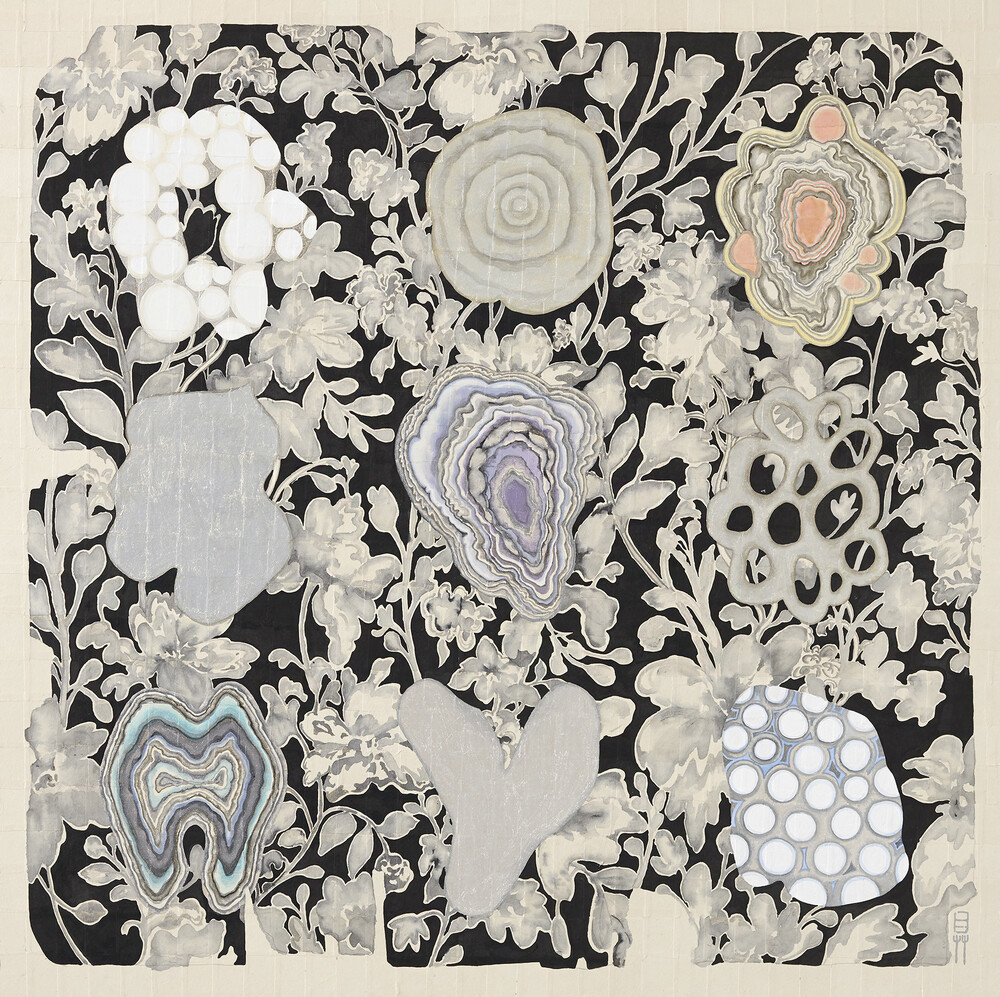
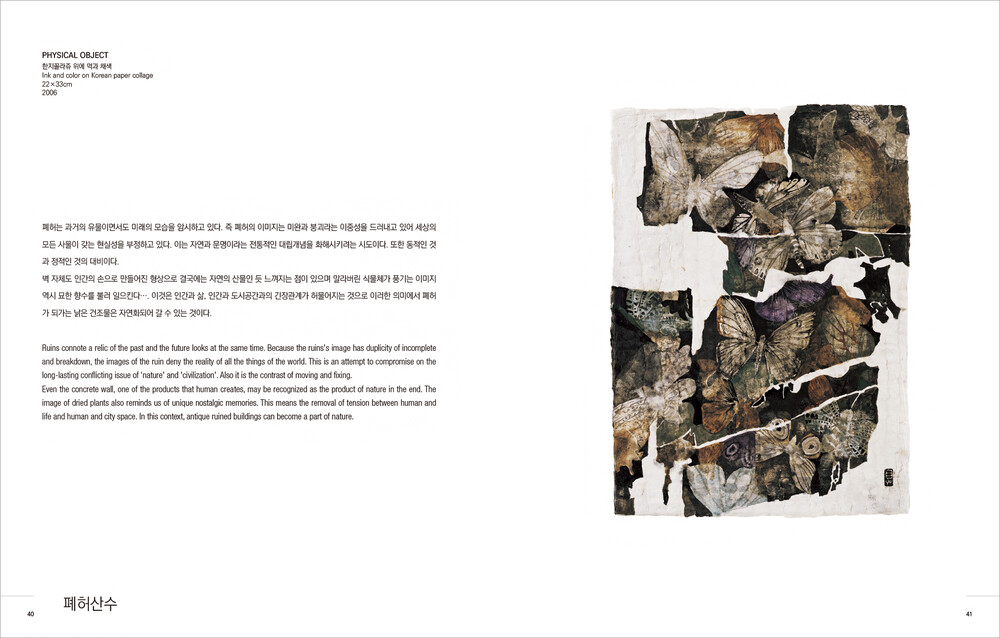
페허는 과거의 유물이면서도 미래의 모습을 암시하고 있다. 즉 폐허의 이미지는 미완과 붕괴라는 이중성을 드러내고 있어 세상의 모든 사물이 갖는 현실성을 부정하고 있다. 이는 자연과 문명이라는 전통적인 대립개념을 화해시키려는 시도이다. 또한 동적인 것과 정적인 것의 대비이다.
벽 자체도 인간의 손으로 만들어진 형상으로 결국에는 자연의 산물인 듯 느껴지는 점이 있으며 말라버린 식물체가 풍기는 이미지 역시 묘한 향수를 불러 일으킨다... 이것은 인간과 삶, 인간과 도시공간과의 긴장관계가 허물어지는 것으로 이러한 의미에서 폐허가 되가는 낡은 건조물은 자연화되어 갈 수 있는 것이다.
Ruins connote a relic of the past and the future looks At the same time. Because the ruins's image have duplicity of incomplete and breakdown ,the images of the ruin deny the reality of all the things of the world . This is an attempt to compromise on the long-lasting conflicting issue of ‘nature' and 'civilization'. Also it is the contrast of moving and fixing.
Even the concrete wall, one of the products that human creates, may be recognized as the product of nature in the end. The image of dried plants also reminds us of uniquenostalgic memories. This means the removal of tension between human and life and human and city space. In this context, antique ruined buildings can become a part of nature.
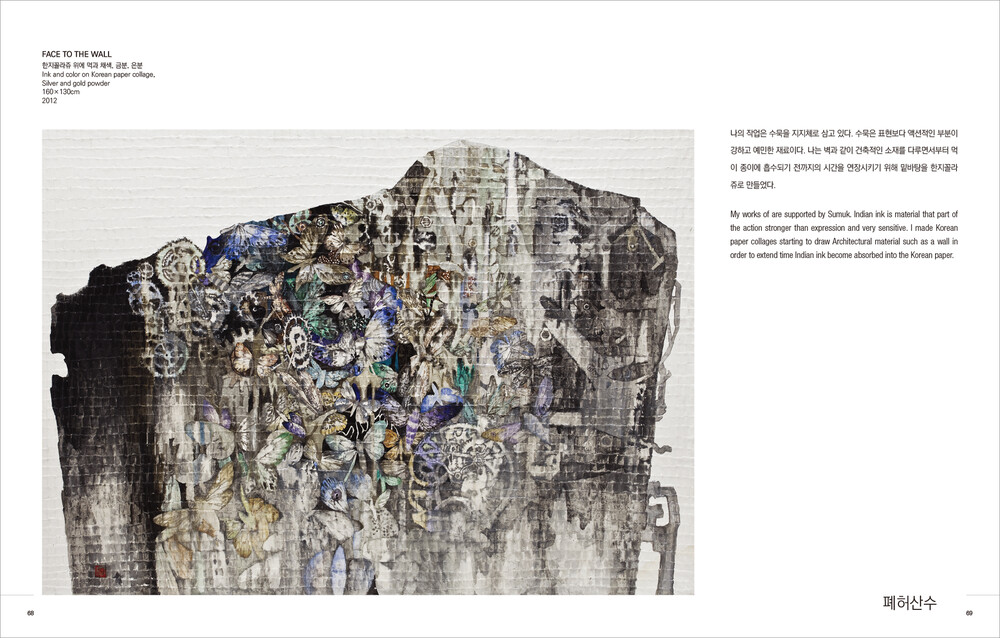
나의 작업은 수묵을 지지체로 삼고 있다. 수묵은 표현보다 액션적인 부분이 강하고 예민한 재료이다. 나는 벽과 같이 건축적인 소재를 다루면서부터 먹이 종이에 흡수되기 전까지의 시간을 연장시키기 밑바탕을 한지꼴라쥬로 만들었다.
어둡고 침잠하는 화면은 다분히 엄숙하고 금욕적이다. 원형으로 이루어진 갖가지 형상들이 어우러져 이루어내는 형상은 익숙하면서도 이질적이다. 그것은 톱니바퀴나 태엽과 같은 기계적 이미지들이 중첩되며 이루어내는 조형물 같다. 그러나 이들은 기계적인 정연함이나 치밀한 구조의 차가운 질서를 드러내기 보다는 오히려 쇄락하고 무너지는 처연한 상황으로 읽혀진다. 그것은 마치 거대한 문명의 폐허처럼 을씨년스러울 뿐 아니라 한없는 침묵의 나락을 연상시킨다. 본래 일정한 에너지를 통해 동작함으로써 본연의 기능을 발휘하고 역할을 수행하던 기계들은 분해되고 해체되어 초라한 속살을 드러내며 그렇게 방치되어 있는 것이다.
폐허산수 · 廢墟山水, 2017 구본아
My works of are supported by Sumuk. Indian ink is material that part of the action stronger than expression and very sensitive. I made korean paper collages starting to draw Architectural material such as a wall in order to extend time Indian ink become absorbed into the korean paper.
Dark and withdrawn screens are somewhat solemn and ascetic. Figures combined with various circles and round shapes are strange although they are familiar to some extent. They look like forms made of redundant mechanical images such as cogwheels or clockwork. However, they are read as old and falling things rather than mechanical precision or cold order of dense structure. It is dreary just like ruins of a great civilization and reminds us of deep fall of silence. Machines which perform original functions and play roles by performing through certain energies are dissolved and dismantled and left there with their humble flesh shown.
Face of the wall, 2017 Bon-a, Koo
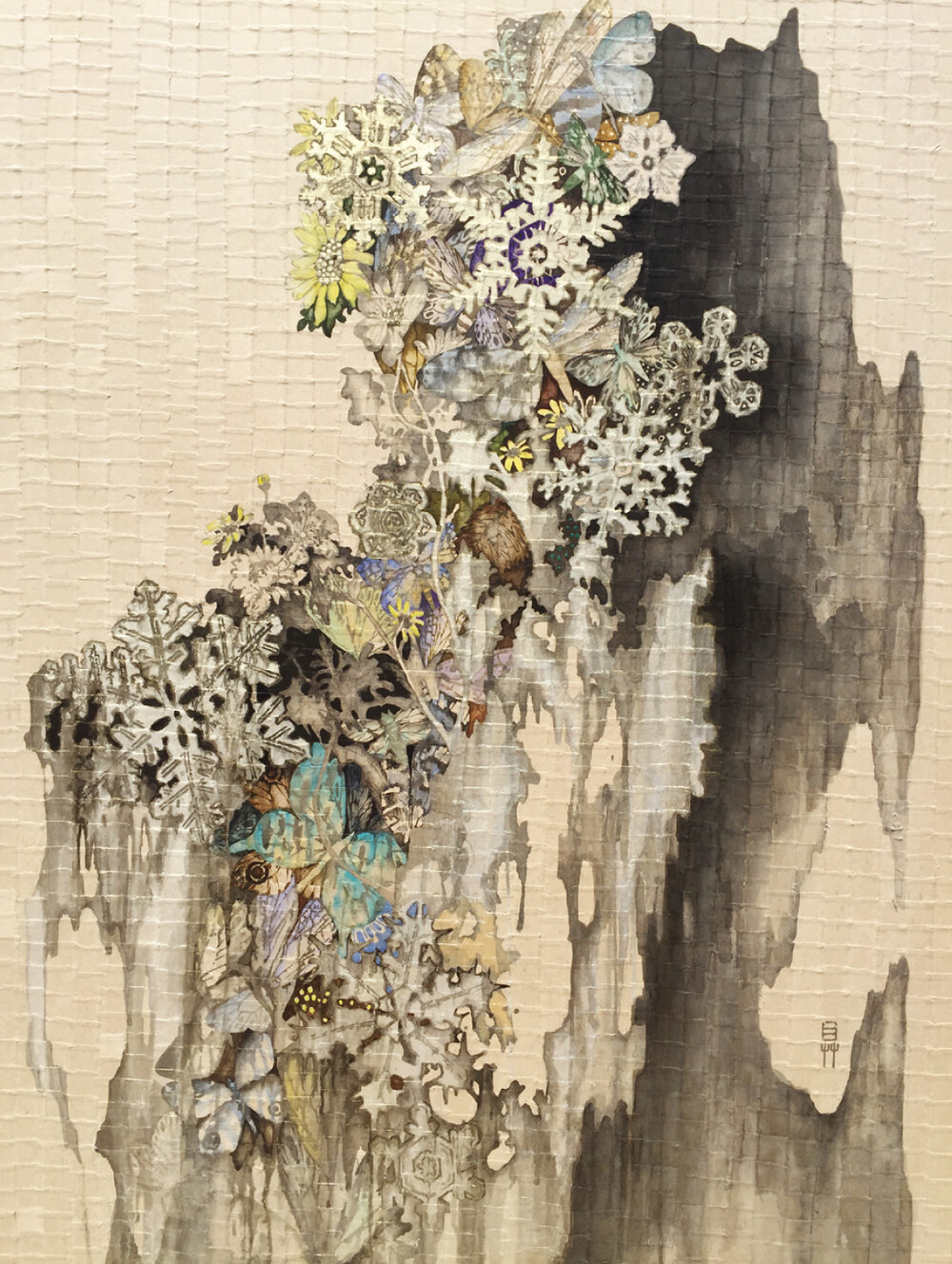
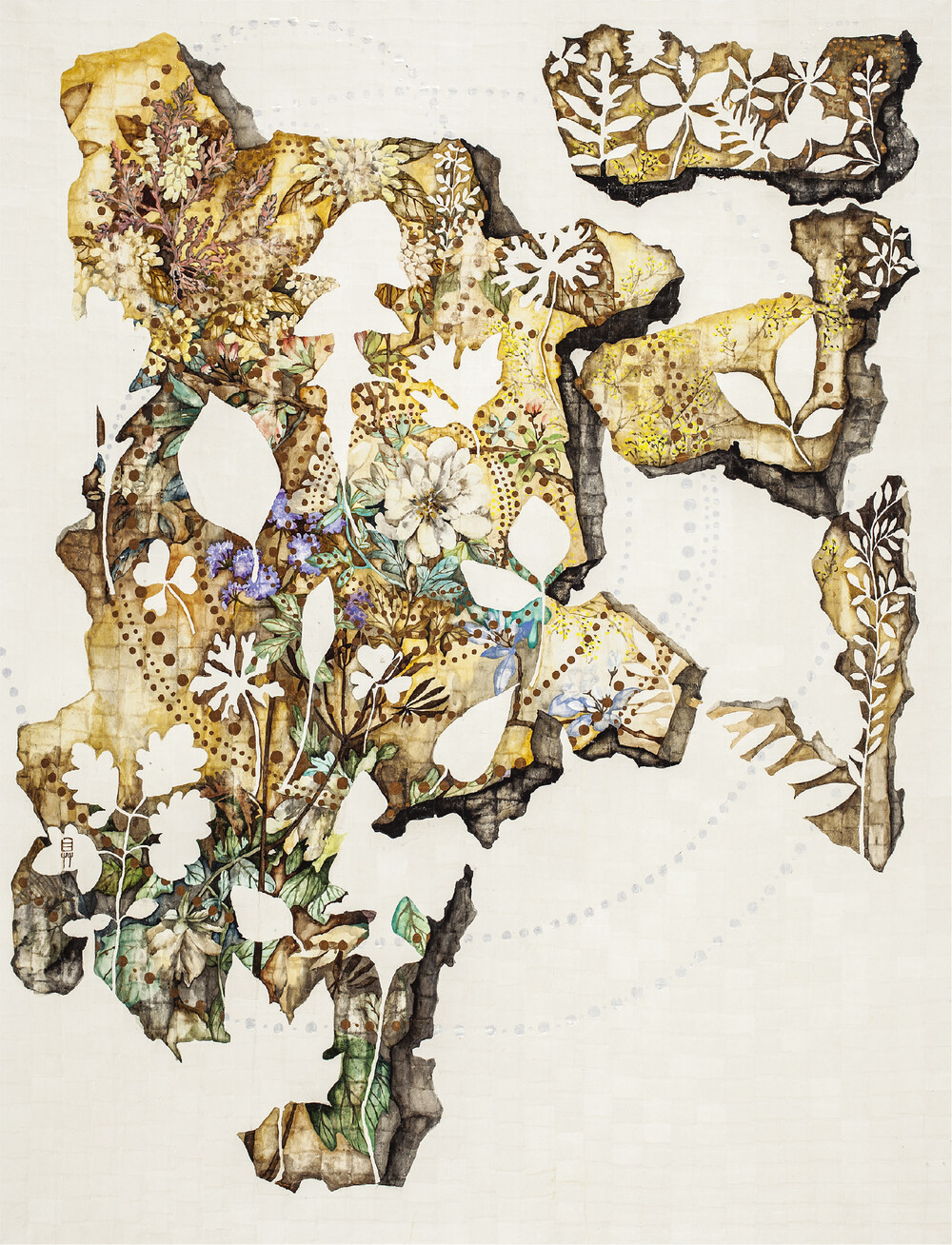
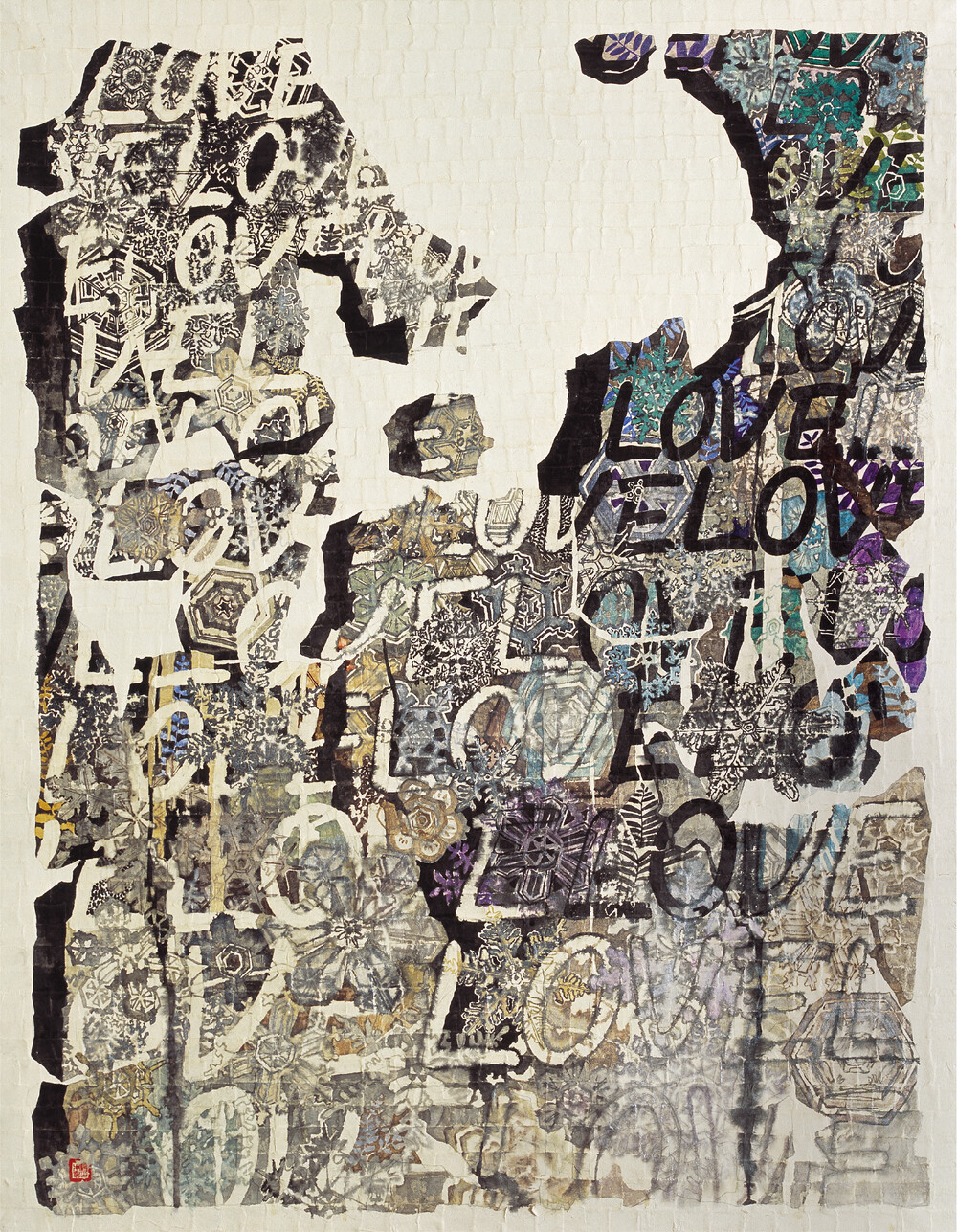
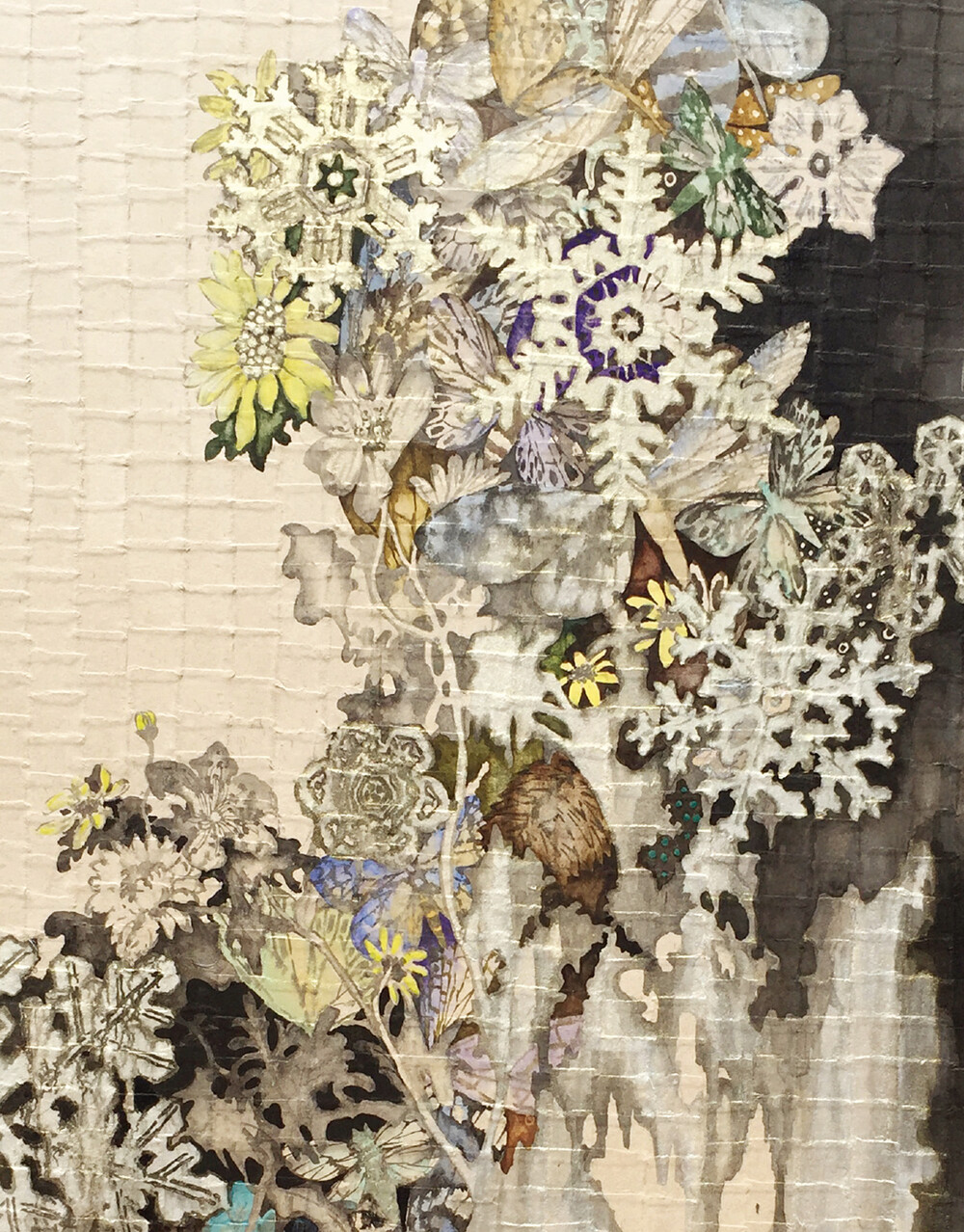
'시간의 이빨'은 본인이 취한 일련의 명제이다. 그것은 바로 온갖 물질과 현상을 쉼 없이 거둬들이는 자연에 대한 표현일 것이다. ‘이빨’이라는 다소 선정적이고 자극적인 단어는 바로 이러한 시간이 지니고 있는 속성에 대한 강조의 의미이다. 시간에 의해 할퀴고 뜯겨져 점차 본연의 형상과 기능은 물론 존재와 존엄성까지 해체되어가는 기계들의 파편은 쓸쓸하고 애달픈 감상일 것이다. 이미 무한의 저편으로 사라질 것을 전제로 한 존재이지만, 그 퇴락하고 스러져감에 비감하지 않을 수 없다. 그것은 기능함으로써 의미를 갖는 기계의 숙명이자 아픔을 통해 확인하는 인간의 삶에 대한 애잔한 감상이다. 나는 이러한 시간의 무덤, 침묵의 시간이 지니고 있는 무서운 현실을 통해 실존을 확인하고 또 절감하는 것인지도 모른다.
“이번 작업에서 채워짐과 비워짐. 그리고 자연과 문명의 순환을 태엽이라는 매개체를 통하여 표현하였다. ‘태엽(胎葉)’, 아이 밸 ‘태’, 이파리 ‘엽’ 의 의미처럼, 시계에 생명을 불어넣기 위해 만든 나뭇잎과 같이 생명을 잉태시키는 틀을 의미한다... 나는 자연과 문명의 화해에서 오는 경외심을 시간의 이빨의 해답으로 찾았다. 경외심의 아름다움이란 바로 그것이 나이와 함께 자란다는 점이다. 경외심은 인내를 필요로 한다, 경외심은 시간에 대한 승리이다. 그것은 파멸의 반대이다. 그것이 바로 완성이라 할 수 있을 것이다.”
이는 나의 작가노트 중 한 부분이다. 나선형으로 감긴 태엽은 아이를 배듯이 사물에 생명력을 불어 넣어주는 생명의 상징인 셈이다. 그것은 감긴 순간에는 살아있듯 움직이지만, 이내 풀어져 멈추게 되면 죽음에 이르게 된다. 인간에게 허용된 것은 바로 감겨진 만큼의 유한한 생명일 것이며, 자연은 그것을 소리없이 거둬들인다. 있고 없고, 살아있고 죽은 것은 그렇듯 단지 존재하는 양상만 다를 뿐이다.
시간의 이빨, 2016 구본아
'Teeth of Time' is the series of proportions of me. It is the expression for the nature which returns all kinds of materials and phenomena without resting. The vulgar and sensational word of ‘Tooth’ is an emphasis of properties of time. The particles of machines which lost existence and dignity as well as its original shape and function are desolate and sad. Although they are supposed to disappear to the other side of infinity, they cannot help being sad. It is the fate of machines that can exist by their functions and the pity for the lives of people which can be confirmed by pains. I identify the existence through the dreadful reality that the tomb of time so to speak the silence of time has.
“In this work, I expressed the filling and emptying and the circulation of nature and civilization through the medium of clockwork. Cogwheel in Chinese characters (胎葉) is made up with ‘胎’ which means pregnancy, and ‘葉’ which means leaves. It means a frame bearing the life just as leaves made to give life to trees........ I found the answer of tooth of time as awe from the reconciliation between nature and civilization. The beauty of awe is that it grows with age. Awe needs patience and it is the victory over time.. It is the opposite of destruction. It can be said as completion.”
It is a part of my artist’s note. The spiral wound clockwork is the symbol of life that gives life to things. It moves as if it were alive when it was wound but it arrives at death when it is fully unwound. What is allowed to human beings is the finite life until being unwound completely. Nature gets it back without puss. Therefore, existence and non‐existence and to be and not to be is the different sides of the same thing.
Teeth of time, 2016 Bon-a, Koo
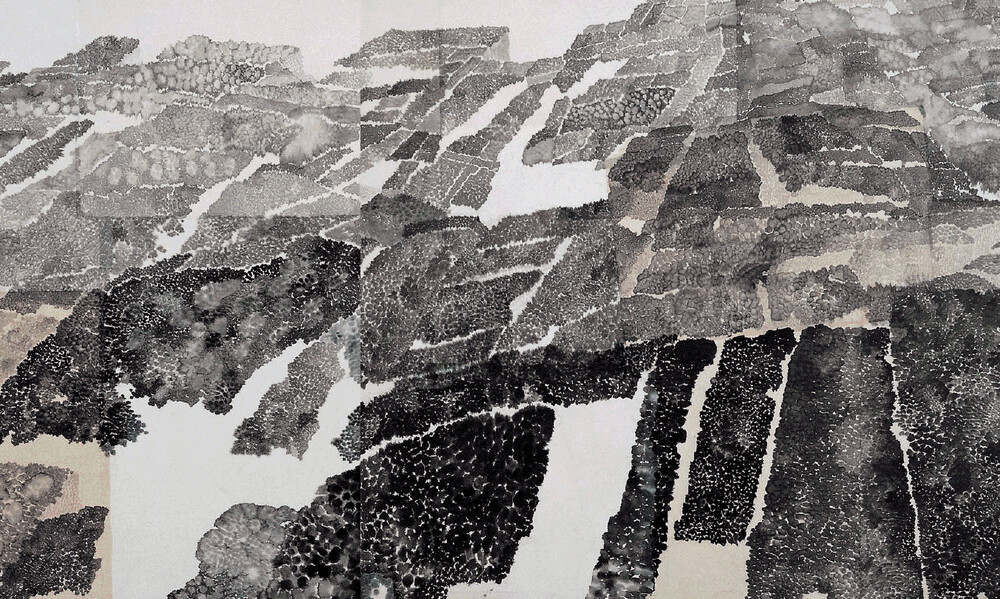
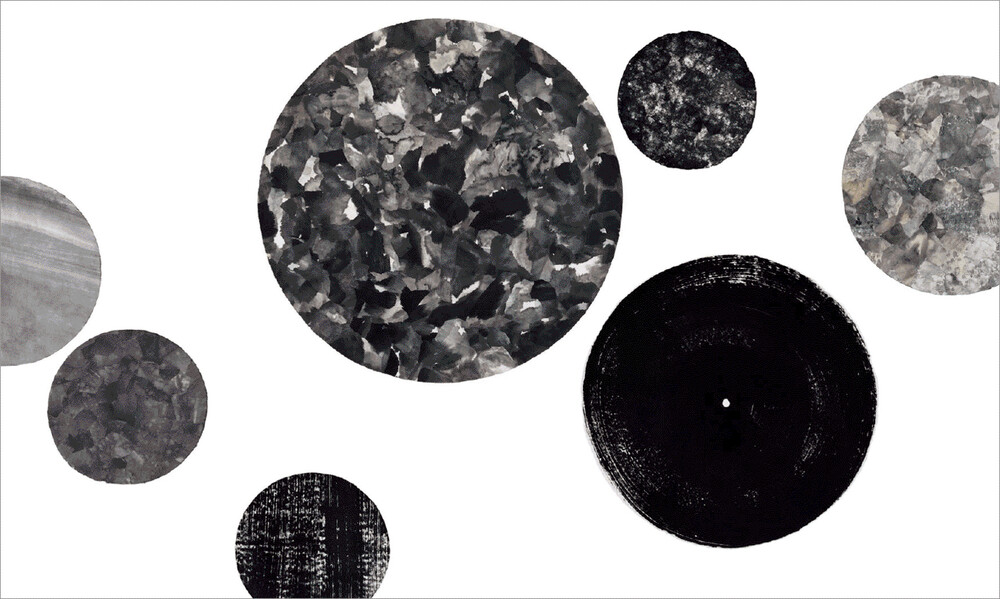
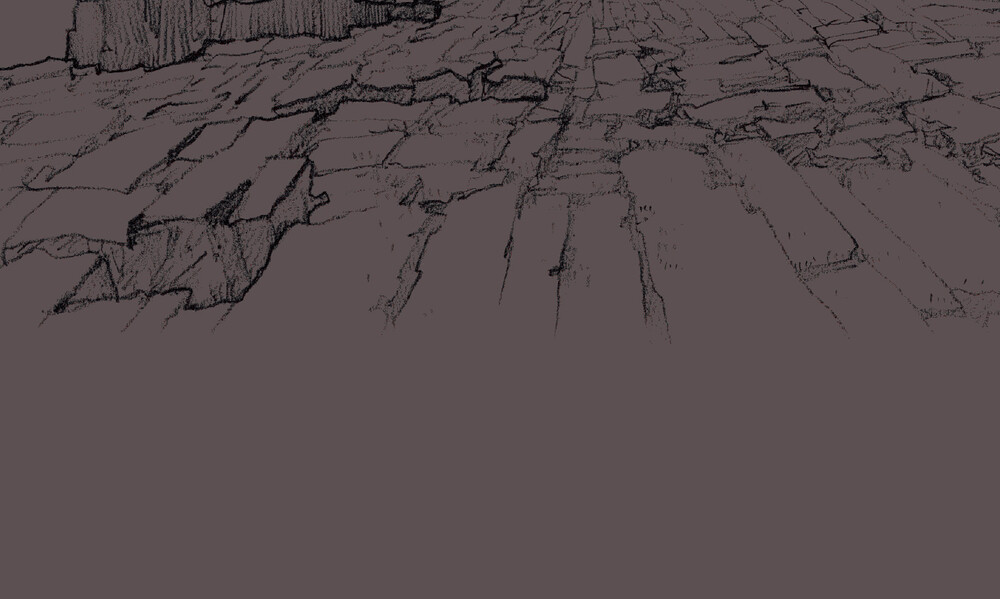
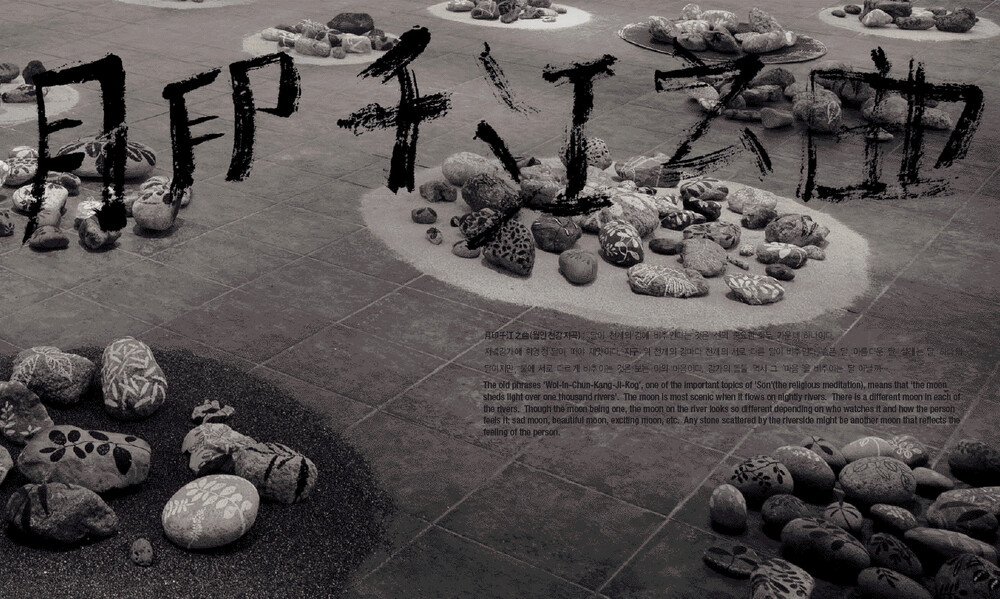
그림은 우리 눈 앞에 펼쳐진 여러 사물들과 이미지를 대상으로 하지만 결국 그것은 인간의 감성과 지각에 대한 문제이며 나아가서는 개인의 시각에 관한 문제이다. 나는 작업에서 사물풍경의 혼돈과 무질서의 요소들을 짜임새 있게 조율하여 자율적 에너지를 가진 통일적 선율을 이끌어 내는데 초점을 맞추었는데, 이를 위해 필요한 것이 ‘物과의 대화’이다. 외부는 곧 내부이고 내부는 바로 외부와 통한다. 곧 ‘物과 나눈 대화’ 라는 것은 ‘외부이자 내부의 선택과 행위의 시공간’을 의미하는 것으로서, 내면에서 생성되는 감정의 세계를 시각화시키는 과정이다. 무언의 사물과 말한다는 것, 즉 말없는 사물들에게 귀 기울이고 그림을 통해 인식의 통로를 여는 것이 이미지의 노예로부터 그림의 강박관념으로 벗어나는 길로, 사물과 나누는 진정 순수한 대화를 통해 가능한 일일 것이다.
작업에 나타난 무너진 벽, 건물의 잔해들은 새로 지은 콘크리트 건물이 아닌 모서리들이 떨어져 나가고, 비와 눈 등 자연의 현상들로 인해 얼룩들로 무늬진 시간성을 느끼게 해주는 낡은 사물들이다. 남겨진 돌, 무너진 벽, 말라버린 식물체 등이 암시하는 난제들은 이미 약간의 시간들이 흘러간 이후의 것으로, 지나간 삶의 문제들과 현재의 자신과의 시간적 거리의식이 이미 건조물 본래의 기능과 현실인식을 상실케하고 관조할 수 있는 미적대상으로 치환케 한다. 이는 문명이라는 전통적인 대립개념을 화해시키려는 시도이다. 벽자체도 인간의 손으로 만들어진 형상으로 결국에는 자연의 산물인 듯 느껴지는 점이 있으며 말라버린 식물체가 풍기는 이미지 역시 묘한 향수를 불러 일으킨다... 이것은 인간과 삶, 인간과 도시공간과의 긴장관계가 허물어지는 것으로 이러한 의미에서 폐허가 되가는 낡은 건조물은 자연화되어 갈 수 있는 것이다.
나의 작업에서의 돌, 벽들은 그 자체가 갖는 조형성과 함께 거기에 나타난 여러 흔적과 형상들, 그리고 주변의 흘러가는 시간과 공간과의 관계를 통하여 나의 경험을 고양시키는 대상이라는 쪽에 더 가깝다. 돌은 죽은 물체로 이루어진 것이 아니라 살아 있는 것으로 종교전통에서 면벽(面壁)의 명상수행처럼 실재에 대한 직접적인 직관으로 안내한다. 즉 돌, 벽 자체라는 물체는 유기적인 무한의 공간이며 나자신과 교감할 수 있는 감정이입의 대상으로 나는 작업을 통하여 그것이 나에게 말하고 있는 단순하고도 복잡한 언어를 표현하려 하였다.
나에게 있어서 작업이란 영원한 생명의 원천과 순환을 표현하고자 하는 것으로 순환의 대상인 모든 사물들이 관객에게나 나에게 있어서도 앞으로도 늘 미지성을 내포하는 반투명한 것을 유지할 수 있기를 바란다.
‘物’과 나눈 대화, 2014 구본아
The paintings are present various physical objects which exist before our eyes and images related thereto; however, those come down to the matter of human's sense and perception, and, furthermore, each individual's view. My works have focused on arranging the chaotic and disordered factors of landscape scenes in a harmonious way so that I can create a self-controlled unity, for which the dialogue with objects is essential. The external world means the internal one and vice versa. 'Dialogue with objects'is based on the space-time world inside which numerous choices and activities are being made between external and internal world; in other words, it is the process of expressing inner feelings in visual ways. Communicationwith the speechless objects, while listening to the speechless objects and perceiving them through paintings, enables us to be free from a stereotyped image and an obsessed notion. Only a sincere and pure dialogue with them makes it possible.
Fallen walls, debris from buildings, etc. with some damages and stains caused by normal wear and tear, rain, wind, etc., which are far from new shiny buildings, depict the elapse of time. Remaining stones, fallen walls, dried plants, etc. have suggested some knotty problems; however, these become somewhat bygone issue. The time gap between the past and the present replaces the perception of 'reality' and 'functional features of buildings' with the perception of 'beautiful objects' in a calm and careful way. This is an attempt to compromise on the long-lasting conflicting issue of 'civilization'. Even the concrete wall, one of the products that human creates, may be recognized as the product of nature in the end. The image of dried plants also reminds us of uniquenostalgic memories. This means the removal of tension between human and life and human and city space. In this context, antique ruined buildings can become a part of nature.
Stones, walls, etc. used for my works play an important role in enriching my experiences through i) numerous marks and forms thereon and ii) the interaction with time and space passing around them, not to the mention the formative features of those stones and walls. Stones are not dead any more. They are alive and they lead us to the direct intuition on one's entities, as is the case of the religious medication facing the wall. In other words, the physical objects such as stones and walls provide an organic unlimited space where the empathy between those objects and me is developed. I've tried to make some efforts to express both simple and complex words that they have said to me through my paintings.
My works have focused on expressing the source and cycle of eternal life; hopefully any and all cyclic objects will remain semitransparent or unknown to me and other spectators.
Dialogue with 'Physical Objects, 2014 bon-a. koo
세상 사람들은 모두 훌륭하고 복잡하고 거대한 장치가
빈틈없이 세계를 움직인다고 생각하오. 하지만 그렇지 않소.
사실은 태엽감는 새가 여러 장소로 가, 가는 곳 곳마다에서
조금씩 조그마한 태엽을 감아 세계를 움직이고 있는 거요.
무라카미 히로키의 소설 '태엽감는 새' 본문 중에서
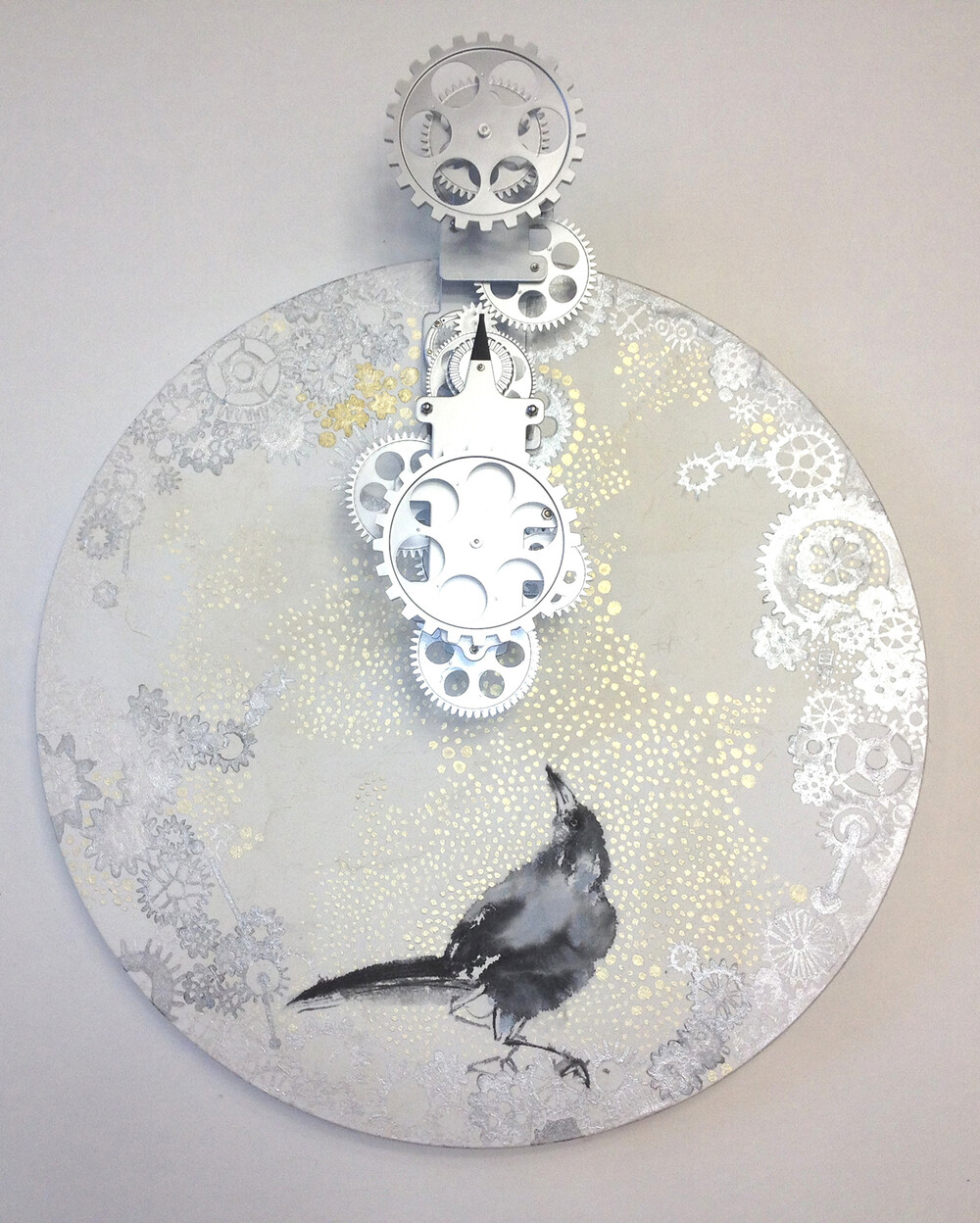
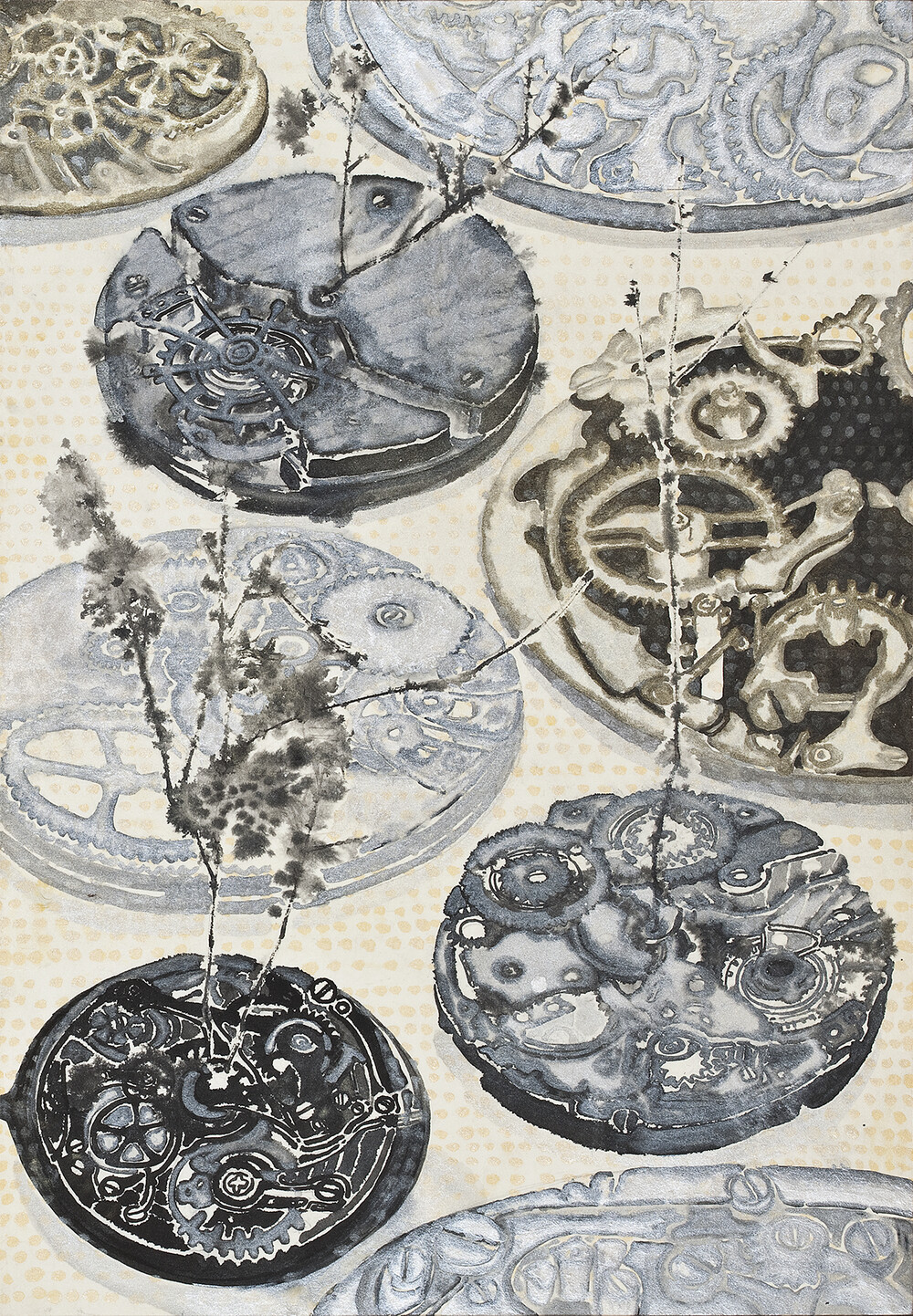
내 작품에 보이는 ‘태엽감는 새’는 존재의 작음과 불확실함에 관한 ‘詩’이다.
오래전에 읽었던 하루키의 소설, ‘태엽 감는 새’를 떠올리며 제작한 신작들은 ‘보이지 않는 손’에 의해 태엽이 감겨져 움직이는 장남감새와 같은 ‘나’를 찿는 여로를 기계장치와 새의 대비를 통해 보여주고자 한 것이다. 또한 채워짐과 비워짐. 그리고 자연과 문명의 순환을 태엽이라는 매개체를 통하여 표현하였다 ‘태엽(胎葉)’, 아이밸 ‘태’, 이파리 ‘엽’ 의 이미처럼 시계에 생명을 불어넣기 위해 만든 나뭇잎처럼 생명을 잉태시키는 틀을 의미한다. 칠팔월의 복숭아 열매는 손대기가 무섭게 ‘탁’하고 터져버려 씨를 산지 사방으로 날려 보내고 껍데기는 소용돌이 모양으로 말려버린다. 그들 세계에서 소용돌이는 생명의 근원이기도 하다. 시계는 생명의 단위이고 연속으로 쉬지말고 움직여야 하기에 인간의 심장대신으로 태엽을 넣어 주었다.
모든 완벽한 것은 언젠가는 망가진다. 내 자명종시계, 63빌딩 ,경복궁, 해안가의 철옹성같은 요새, 사랑받는 옆집 똥개강아지도 마찬가지이다. 모든 것이 완전한 상태를 유지하는 것은 오직 순간뿐이다. 태엽을 감는다는 것은 청춘이 지나가고 있는 나의 지금에도 내가 여전히 느끼고 있는 세상에 대한 불안감과 공허함의 표현일지도 모른다. 일상의 도처에 깔린 ‘현실’과 눈에 보이지는 않지만 엄연히 존재하는 ‘비현실’이 두 세계를 경계 짖는 시간속에 속에서 교차한다. 모든 인간에게 있는 두 세계를 넘나들며 나는 누구인가, 그 존재 이유는 무엇인가를 발견하고 싶은 나의 조용한 외침일 수 도 있다.
태엽감는 새, 2013 구본아